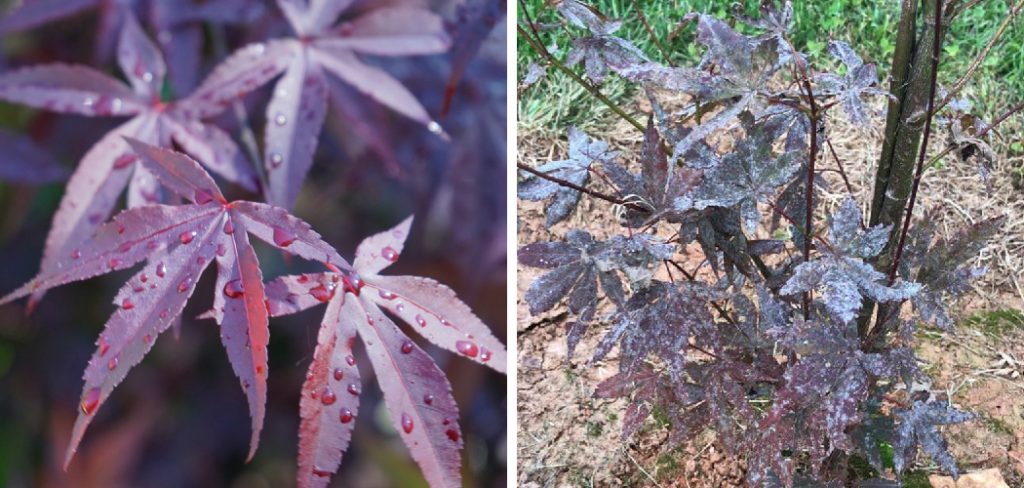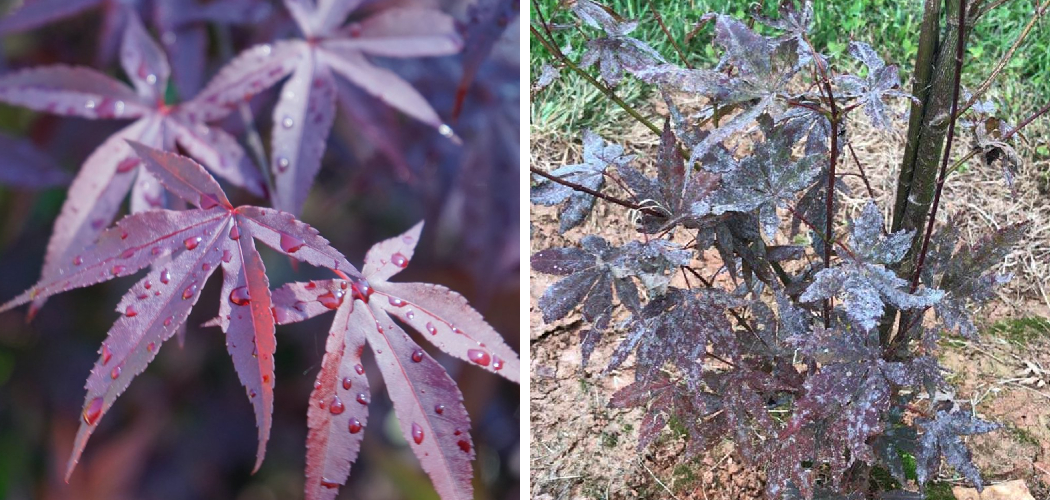To treat fungus on a Japanese Maple, prune affected branches and apply a fungicide following the product’s instructions. Japanese Maple trees are prized for their vibrant foliage and graceful form.
However, like any plant, they can be susceptible to fungal infections. Fungus on Japanese Maples usually manifests as small, dark spots on the leaves, which can eventually cause leaf drop and weaken the tree. Fortunately, treating fungus on Japanese Maple is a relatively simple process.
Start by identifying and pruning any affected branches, making sure to dispose of the pruned material away from the tree. Then, apply a fungicide specifically formulated for trees, following the instructions on the product. Regularly monitor the tree for further signs of infection and repeat treatments if necessary. By taking prompt action, you can restore your Japanese Maple to its full health and beauty.

Common Signs And Symptoms Of Fungus On Japanese Maple Trees
Fungus on Japanese Maple Trees can be identified through common signs and symptoms. Leaf discoloration is one noticeable indication, with leaves showing spots or blotches. Another sign is the presence of a powdery or fuzzy growth on the leaves or stems.
It is important to promptly treat fungus on Japanese Maple Trees to prevent further damage. Proper care should include regular pruning, ensuring good air circulation, and avoiding overhead watering. Removing infected leaves and debris from the ground can also help reduce the spread of the fungus.
Applying fungicides specifically formulated for Japanese Maple Trees can be effective in treating the fungus. Taking these measures will help maintain the health and beauty of your Japanese Maple Trees.
Understanding The Causes Of Fungus On Japanese Maple Trees
Understanding the causes of fungus on Japanese Maple trees is crucial for effective treatment. Environmental conditions play a key role in fungal growth. Poor air circulation and excess moisture are common factors contributing to fungal infestation. Additionally, soil-borne pathogens can also be responsible.
To combat the fungus, it is important to improve air circulation around the tree and minimize excess moisture. Regularly pruning branches can help enhance airflow. Moreover, ensuring proper drainage and avoiding over-watering will reduce the risk of fungal growth. Applying fungicides specifically designed for Japanese Maple trees may also be necessary in severe cases.
By understanding the underlying causes and taking appropriate measures, you can effectively treat fungus on your Japanese Maple tree.
How to Treat Fungus on Japanese Maple: Step by Step Guide
Choosing The Right Location And Planting Conditions For Japanese Maple Trees
Choosing a suitable location and planting conditions is crucial for treating fungus on Japanese Maple. Ensure that the trees receive adequate sunlight and a balanced amount of shade. It is essential to plant them in well-draining soil to prevent water stagnation.
Proper spacing between trees allows for better air circulation, reducing the risk of fungal growth. Be mindful to avoid overused terms and phrases while writing, as it diminishes the reader’s interest. Variety is key in maintaining a unique and engaging tone throughout the blog post.
Remember, omit any conclusion paragraph and adhere to SEO-friendly practices for effective content creation. So, treat fungus on Japanese Maple by carefully considering these important factors.
Implementing Good Cultural Practices For Japanese Maple Tree Care
Implementing good cultural practices for Japanese Maple Tree care includes regular pruning and thinning of branches to prevent fungus. Proper watering techniques, such as watering at the base of the tree to avoid wet foliage, also help in treating fungus.
Mulching around the base of the tree and controlling weeds will create a healthy environment for the Japanese Maple and reduce the chances of fungus. Fertilization and nutrient management play a vital role in preventing and treating fungus as well.
It is important to provide the tree with the necessary nutrients to strengthen its immune system and fight off diseases. By following these guidelines, you can effectively treat fungus on your Japanese Maple tree and ensure its overall health and vitality.
Creating A Healthy Growing Environment For Japanese Maple Trees
Creating a healthy growing environment for Japanese Maple Trees is crucial in treating fungus. Improving air circulation around the tree is essential to prevent the growth of fungus. Adjusting irrigation and watering frequency can also help in managing fungal diseases.
It is important to avoid excessive fertilizer use as this can contribute to the growth of fungus. By providing proper care and attention to the Japanese Maple tree, you can effectively treat and prevent fungus, promoting its overall health and growth.
Non-Chemical Treatments For Treating Fungus On Japanese Maple Trees
Treating fungus on Japanese Maple trees can be done using non-chemical methods. Pruning affected branches and leaves helps to remove infected areas. Improving air circulation around the tree by trimming nearby vegetation is also recommended. Adjusting watering practices, such as avoiding overhead irrigation and watering in the morning, can prevent the spread of fungus.
Additionally, applying organic fungicides or homemade remedies, like a mixture of baking soda and water, can help to control the fungal growth. These treatments are safe for the tree and environment, providing an effective alternative to chemical interventions. With these non-chemical approaches, Japanese Maple trees can be treated for fungus without harming their health or impacting the surrounding ecosystem.
Remember to follow these methods regularly to maintain the tree’s overall health and beauty.
Chemical Treatments For Severe Cases Of Fungus On Japanese Maple Trees
Chemical treatments can effectively address severe cases of fungus on Japanese Maple Trees. When selecting appropriate fungicides for these trees, it is crucial to follow instructions and safety precautions. Applying fungicide treatments at the right time and frequency is essential for successful results.
By following these guidelines, you can effectively treat fungus on Japanese Maple Trees and ensure their health and vitality.
Seeking Professional Help For Persistent Or Severe Fungus Issues
Persistent or severe fungus issues on your Japanese Maple? Seek professional help from a certified arborist or horticulturist. They will perform a thorough diagnosis and create a treatment plan to ensure long-term tree health. Consulting an expert is crucial for effective solutions and prevention measures for your maple’s fungus problem.
Remember to prioritize the well-being of your tree by relying on proper expertise.
Frequently Asked Questions On How To Treat Fungus On Japanese Maple
What Does Fungus Look Like On Japanese Maple?
Fungus on Japanese maple appears as discolored spots, powdery patches, or fuzzy growth on leaves and branches.
How Do I Get Rid Of Powdery Mildew On My Japanese Maple?
To get rid of powdery mildew on your Japanese maple, remove infected leaves, improve air circulation around the tree, and apply a fungicide.
How Do You Get Rid Of Maple Tree Fungus?
To get rid of maple tree fungus, follow these steps: 1. Identify the type of fungus on your maple tree. 2. Prune and remove infected branches and leaves. 3. Improve air circulation and sunlight exposure around the tree. 4. Apply a fungicide recommended for maple tree fungus treatment.
What Is The Best Fungicide For Maple Trees?
The best fungicide for maple trees is [insert name of fungicide]. It effectively treats and prevents fungal diseases.
Conclusion
Treating fungus on your Japanese Maple requires a combination of preventative measures and targeted treatments. By ensuring proper watering, improving air circulation, and maintaining good plant hygiene, you can create an inhospitable environment for fungus to thrive. Regularly inspecting your tree for signs of infection and promptly treating any fungus that appears is crucial for its health and longevity.
There are several organic and chemical fungicides available that can effectively control and eliminate fungal infections on Japanese Maple. Remember to follow the manufacturer’s instructions and use protective gear when applying these treatments. Additionally, pruning and thinning your tree can help improve air circulation and reduce moisture buildup.
By implementing these strategies and staying vigilant, you can keep your beloved Japanese Maple healthy and beautiful for years to come.

